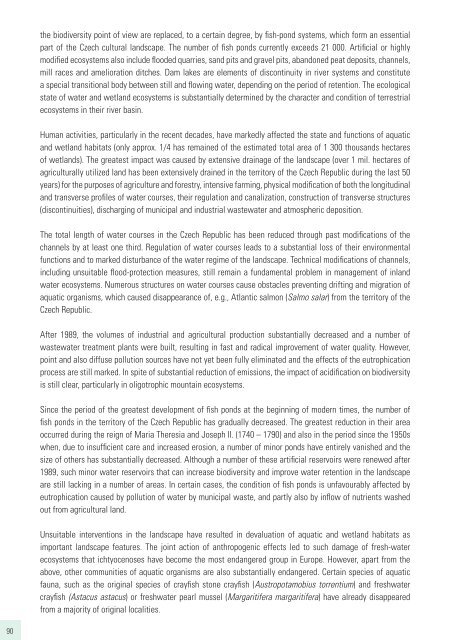B - Convention on Biological Diversity
B - Convention on Biological Diversity
B - Convention on Biological Diversity
- No tags were found...
You also want an ePaper? Increase the reach of your titles
YUMPU automatically turns print PDFs into web optimized ePapers that Google loves.
the biodiversity point of view are replaced, to a certain degree, by fish-p<strong>on</strong>d systems, which form an essentialpart of the Czech cultural landscape. The number of fish p<strong>on</strong>ds currently exceeds 21 000. Artificial or highlymodifi ed ecosystems also include flooded quarries, sand pits and gravel pits, aband<strong>on</strong>ed peat deposits, channels,mill races and ameliorati<strong>on</strong> ditches. Dam lakes are elements of disc<strong>on</strong>tinuity in river systems and c<strong>on</strong>stitutea special transiti<strong>on</strong>al body between still and flowing water, depending <strong>on</strong> the period of retenti<strong>on</strong>. The ecologicalstate of water and wetland ecosystems is substantially determined by the character and c<strong>on</strong>diti<strong>on</strong> of terrestrialecosystems in their river basin.Human activities, particularly in the recent decades, have markedly affected the state and functi<strong>on</strong>s of aquaticand wetland habitats (<strong>on</strong>ly approx. 1/4 has remained of the estimated total area of 1 300 thousands hectaresof wetlands). The greatest impact was caused by extensive drainage of the landscape (over 1 mil. hectares ofagriculturally utilized land has been extensively drained in the territory of the Czech Republic during the last 50years) for the purposes of agriculture and forestry, intensive farming, physical modificati<strong>on</strong> of both the l<strong>on</strong>gitudinaland transverse profiles of water courses, their regulati<strong>on</strong> and canalizati<strong>on</strong>, c<strong>on</strong>structi<strong>on</strong> of transverse structures(disc<strong>on</strong>tinuities), discharging of municipal and industrial wastewater and atmospheric depositi<strong>on</strong>.The total length of water courses in the Czech Republic has been reduced through past modificati<strong>on</strong>s of thechannels by at least <strong>on</strong>e third. Regulati<strong>on</strong> of water courses leads to a substantial loss of their envir<strong>on</strong>mentalfuncti<strong>on</strong>s and to marked disturbance of the water regime of the landscape. Technical modificati<strong>on</strong>s of channels,including unsuitable flood-protecti<strong>on</strong> measures, still remain a fundamental problem in management of inlandwater ecosystems. Numerous structures <strong>on</strong> water courses cause obstacles preventing drifting and migrati<strong>on</strong> ofaquatic organisms, which caused disappearance of, e.g., Atlantic salm<strong>on</strong> (Salmo salar) from the territory of theCzech Republic.After 1989, the volumes of industrial and agricultural producti<strong>on</strong> substantially decreased and a number ofwastewater treatment plants were built, resulting in fast and radical improvement of water quality. However,point and also diffuse polluti<strong>on</strong> sources have not yet been fully eliminated and the effects of the eutrophicati<strong>on</strong>process are still marked. In spite of substantial reducti<strong>on</strong> of emissi<strong>on</strong>s, the impact of acidificati<strong>on</strong> <strong>on</strong> biodiversityis still clear, particularly in oligotrophic mountain ecosystems.Since the period of the greatest development of fish p<strong>on</strong>ds at the beginning of modern times, the number offi sh p<strong>on</strong>ds in the territory of the Czech Republic has gradually decreased. The greatest reducti<strong>on</strong> in their areaoccurred during the reign of Maria Theresia and Joseph II. (1740 – 1790) and also in the period since the 1950swhen, due to insufficient care and increased erosi<strong>on</strong>, a number of minor p<strong>on</strong>ds have entirely vanished and thesize of others has substantially decreased. Although a number of these artificial reservoirs were renewed after1989, such minor water reservoirs that can increase biodiversity and improve water retenti<strong>on</strong> in the landscapeare still lacking in a number of areas. In certain cases, the c<strong>on</strong>diti<strong>on</strong> of fish p<strong>on</strong>ds is unfavourably affected byeutrophicati<strong>on</strong> caused by polluti<strong>on</strong> of water by municipal waste, and partly also by infl ow of nutrients washedout from agricultural land.Unsuitable interventi<strong>on</strong>s in the landscape have resulted in devaluati<strong>on</strong> of aquatic and wetland habitats asimportant landscape features. The joint acti<strong>on</strong> of anthropogenic effects led to such damage of fresh-waterecosystems that ichtyocenoses have become the most endangered group in Europe. However, apart from theabove, other communities of aquatic organisms are also substantially endangered. Certain species of aquaticfauna, such as the original species of crayfish st<strong>on</strong>e crayfi sh (Austropotamobius torrentium) and freshwatercrayfi sh (Astacus astacus) or freshwater pearl mussel (Margaritifera margaritifera) have already disappearedfrom a majority of original localities.90
















